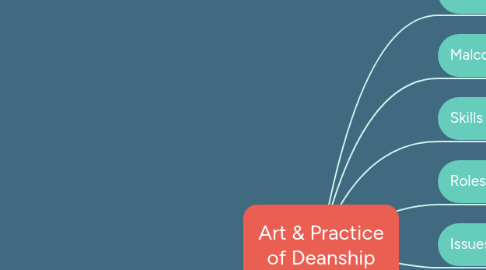
1. Partnerships
1.1. Ingredients for success
1.1.1. Mutual respect
1.1.2. Open & honest communication
1.1.3. Shared goals
1.1.4. Celebrate success
1.2. Learn & Leverage personal attributes
1.2.1. Personality
1.2.1.1. Comfort zone
1.2.2. Work style
1.2.2.1. Communication & decision making style
1.2.3. Relationships of Influence
1.2.3.1. Campus
1.2.3.2. Community
1.2.3.3. National
1.2.3.4. International
1.3. The Dean expects his/her faculty & colleagues to
1.3.1. Be honest
1.3.2. Be loyal
1.3.3. Avoid wasting time
1.3.4. Know the vision
1.3.5. Plan
1.3.6. Push
1.3.7. Share the enthusiasm
1.3.8. Stay focused
1.3.9. Support
1.4. The Dean creates a Philantrophic culture by
1.4.1. Articulating the college's vision & academic plan
1.4.2. Appropriate time & resources for advancement functions
1.4.3. Establishing a collaborative environment where faculty & staff work in concert to achieve the strategic plan
2. Malcolm Baldrige Framework
2.1. a systems perspective for achieving continuous education quality improvement
2.2. Core values
2.2.1. Leadership
2.2.2. Strategic Planning
2.2.3. Student, Stakeholder, and Market Focus
2.2.4. Measurement, Analysis & Knowledge Management
2.2.5. Faculty & Staff Focus
2.2.6. Results
2.3. Framework
2.4. Good practices
2.4.1. Agility
2.4.2. Focus on future
2.4.3. Focus on results & creating value
2.4.4. Learning-centered education
2.4.5. Management by fact
2.4.6. Managing for innovation
2.4.7. Organizational & personal learning
2.4.8. Social responsibility
2.4.9. Systems perspective
2.4.10. Valuing faculty, staff, and partners
2.4.11. Visionary leadership
2.5. Pillars of Total Quality
2.5.1. The organization must focus, first & foremost, on its suppliers and customers
2.5.2. Everyone in the organization must be dedicated to continual improvement, personally and collectively
2.5.3. The organization must be viewed as a system, and the work done within the system must be seen as ongoing process
2.5.4. The success of total quality management is the responsibility of top management
3. Skills Needed to Fulfill the Role of the Dean
3.1. Administrative preparation
3.2. Assessment & accountability
3.3. Commitment to lifelong learning
3.4. Constant thirst for knowledge
3.5. Courage to embrace change in the ever-evolving world of HE
3.6. Creative management
3.7. Democratic leadership
3.8. Finely tuned human relation skills
3.9. Information & educational technologies
3.10. Instructional leadership
3.11. Knowledge of the mission, philosophy, and history of the institution
3.12. Learner-centered orientation
4. Roles of the Dean
4.1. Multifaceted
4.2. Challenging
4.3. Ambigous
5. Issues on Deanship
5.1. Various types of HEI
5.2. Different levels of work, assorted areas, different capacities
5.3. Many types of Deans
5.4. Ever changing HE environment
6. Evolution of Dean's Roles
6.1. The Dean in the Early Years
6.1.1. Rudolph, 1990
6.1.2. Barr, Dessler, et al., 2000
6.2. The Modern Day Dean
6.2.1. Gould, 1964
6.2.2. Wolverton, Gmelch, Montez and Nies, 2001
6.3. Deans for the Future
6.3.1. Gatekeepers of standards
6.3.2. Need to be caring and concerned more about the students
7. Foremost trait = Ability to be a Leader
7.1. The Dean needs to
7.1.1. Perform service
7.1.2. Be accountable
7.1.3. Fulfill a moral role
7.1.4. Act as a steward
7.1.5. Build diverse communities with trust & collaboration
7.1.6. Promote excellence
7.2. Decision-making responsibilities
7.2.1. Educational program/curriculum
7.2.2. Faculty selection, promotion & development
7.2.3. Student affairs
7.2.4. Finance
7.2.5. Physical facilities development
7.2.6. Public & Alumni relations
7.3. The Dean as a Leader
7.3.1. Contemplating a very complex & unstable relation of an individual to the greater social body
7.3.2. Dramatize for everyone the shifting & elusive relation of the one to many
7.3.3. Linchpin holding an organization together between those perceived as leaders & those whose works rest the reputation of the organization
7.3.4. Creating stage for future operations while managing day-to-day activities
7.4. Types of Leaders
7.4.1. Transactional Leaders
7.4.1.1. Determines what subordinates need to do
7.4.1.1.1. To achieve their own and organizational objectives
7.4.1.1.2. Classify those requirements
7.4.1.1.3. Help subordinates become confident that they can reach their objectives by expending the necessary efforts
7.4.1.1.4. Reward them according to their accopmlishments
7.4.2. Transformational Leaders
7.4.2.1. Motivate subordinates to do more than they originally expected to do, by
7.4.2.1.1. Raising followers' level of consciousness about the importance and value of designating outcomes and about ways of reaching them
7.4.2.1.2. Getting followers to transcend their own self-interest for the sake of the team, organization or a larger polity
7.4.2.1.3. Raising the followers' need levels to the higher-order needs, such as self-actualization, or by expanding their portfolio of needs
7.5. Communication Tips
7.5.1. Small talk
7.5.1.1. The concept of inconveniencing oneself
7.5.2. Written communications
7.5.2.1. Critical connection to individuals & groups, inside & outside the school
7.5.3. Faculty & Staff groups
7.5.3.1. Establishing committees & recognizing existing groups are powerful tools for strengthening communications
7.5.4. Communicate with students
7.5.5. Communicate with parents
8. Challenges
8.1. Areas on guidance counselling and advising
8.2. Students are not sufficiently motivated or academically prepared to take advantage of a college education
8.3. Offering curricular programs that lead to unemployment or underemployment
8.4. Teach more, focus more on research that is relevant to society, and rely more on technology
8.5. Exorbitant cost to receive a baccalaureate degree
8.6. The lowering or compromising of standards
9. Administrative Concerns
9.1. Administrative functions
9.1.1. Promotion & maintenance of good standards of work
9.1.2. Coordination of practice with policies of Administration
9.1.3. Assurance of an efficient & smooth-running office
9.2. Primary Problem
9.2.1. The correct, effective & appropriate implementation of university policies & procedures
9.3. Primary Goal
9.3.1. Ensure adherence to policy & procedure
